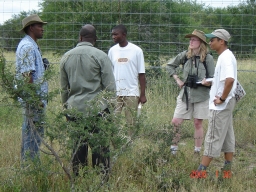Monitoring South Africa’s valuable rangelands
|
Rangelands cover more than 80% of the land surface of South Africa and are critical for sustained provision of essential ecosystem goods and services (Photo © Mitzi du Plessis) |
|
Dr Luthando Dziba of the ARC oversees rangeland monitoring at the Nkuhlu exclosure in the Kruger National Park (Photo © ARC) |
|
Prof Tim O’Connor, SAEON’s representative in the rangeland monitoring initiative (Photo © Mitzi du Plessis) |
The Agricultural Research Council (ARC), on behalf of the National Department of Agriculture and with direct support from SAEON, has recently launched an initiative to assess and monitor rangeland degradation across the country.
Rangelands cover more than 80% of the land surface of South Africa and are critical for sustained provision of essential ecosystem goods and services. They make an obvious contribution to economic development through agriculture and a supply of affordable food products. Livestock production, both large and small-scale commercial, depends largely on rangelands. Informal graziers also depend directly on rangelands for their livelihoods.
Primary terrestrial store of carbon
Rangelands provide us with high quality water, considered by many to be the single most important commodity underpinning our economic development. Rangelands are also the primary terrestrial store of carbon in the country simply on account of their scale, an important attribute in this era of climate change. They provide habitat for many species of our flora and fauna which do not occur in sufficient numbers or at all within protected areas. This same flora and fauna is the source of medicinal products used by over 27 million consumers per annum.
Our society cannot afford deterioration of these services through rangeland degradation. Yet both commercial ranchers and informal graziers will graze their rangelands intensively during poor years as, they argue, a matter of survival. When good rains return, bringing verdant growth, previous punishment of rangelands is soon forgotten.
Rangeland ecology has been a vibrant discipline in this country, revealing that degradation usually occurs slowly enough over time that land users do not remember the original condition of the environment. It is, therefore, the objective of this initiative to monitor the direction and magnitude of change over time and eventually shed strategic-level insight into sustainable management of rangelands.
Long-term monitoring is essential
Maintaining rangeland condition is essential for effective management of our natural renewable resources. Policy and decision-makers require sound information if rangeland degradation is to be forestalled. Tim Hoffmann and colleagues produced a groundbreaking account of rangeland degradation in this country, popularised in their book Nature Divided, but they emphasised the need for direct study rather than expert opinion only, and the need for a longer time frame than the ten years of change over the 1990s that they documented.
Monitoring is the only means whereby information of this nature can be gained. The need for and value of remote-sensing approaches to monitoring degradation is self-evident, but these approaches can only provide part of the answer on their own.
Complementary ground-based monitoring is also needed, and is the focus of this initiative. It builds on the plethora of well designed monitoring efforts, vegetation survey, and phytosociological studies which were undertaken from the 1960s through to the 1980s by resource management departments (agriculture, water affairs, forestry, conservation), academics, and consultants.
Most of these ventures were not as successful as hoped in providing ongoing information for management decision making, but they left a legacy of a geographically comprehensive data base, if resampled, for assessing the extent and nature of rangeland change over an interval of about 20-40 years.
Although preceding the advent of Global Positioning Systems, most sample plots were mapped accurately enough to be relocated. Collectively, these studies sampled the main climatic and soil gradients, and different land uses and management practices.
National effort
A national effort begins with individual studies which will have value in their own right in terms of regional or landscape-level change, but the whole will definitely be much greater than the sum of the parts. Implementation of this project will be achieved through a number of routes, one of which will be postgraduate study.
Should anyone be interested in enquiring further about this venture or the possible opportunities it presents, they should contact the writers of this article - Dr Luthando Dziba at ldziba@arc.agric.za (project co-ordinator) or Prof Tim O’Connor at timoconnor@xsinet.co.za (SAEON representative).













